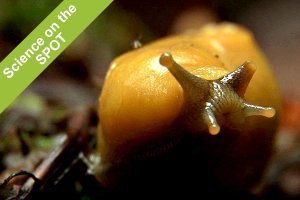 QUEST treks into the old growth redwood forest in search of the Pacific Banana Slug, Ariolomax dolichophallus.
QUEST treks into the old growth redwood forest in search of the Pacific Banana Slug, Ariolomax dolichophallus.
The slow, small, but quite vibrant life on the forest floor can often go completely unnoticed as we hustle and bustle past on our hiking trips, picnics or family outings. Often times the little world on the ground is misinterpreted as insignificant. If noticed at all, a mushroom, snail or salamander might only capture our interest for a short while before the pull of seeing something new draws us away. Patience is not a trait most of us humans possess enough to truly appreciate the goings on in the tiny world of the seemingly unhurried.
A common misconception then is people just aren’t that interested in things that are little, sluggish and quiet. They want big, fast and ferocious! In the wildlife film world we see many movies about lions, cheetahs, grizzly bears, wolves or elephants. Heck, one cable channel devotes an entire week each year just on sharks. This isn’t a bad thing. The charismatic mega-fauna and the world they inhabit fascinate us. It’s natural. But taking the time to discover the small world beneath our feet can have its benefits as well. And looking down through a different lens can provide some wonderful little surprises- a cluster of convergent ladybugs beneath a fallen leaf, redwood sorrel opening with the shade, or a spinning spider’s elaborate web catching a breeze in the glistening sun. There is a whole community of life under each rock, little gems left for those who are careful and take the time.
It is for this that we set out on our adventure into the misty redwood canopy in hunt of a slug - The Pacific banana slug to be exact. They are not fast but can be surprisingly elusive. Belonging to the genus Ariolomax, there are three main species of banana slugs; columbianus, californicus and dolichophallus, – as well as two other known subspecies. Most banana slugs live in the temperate rainforests and fog-zones of the Pacific Coast. Banana slugs’ size, shape and coloring reflect their name as most tend to be long and yellow, some having brown or black spots. However, they can also be light-brown, greenish, perhaps black, or even white. They are the second largest slug in the world and can grow up to ten inches long. Banana slugs serve an important role in the forest ecosystem. Feeding on detritus, (fallen leaves, mushrooms and even dead animals) they recycle nutrients and help replenish the soil
Since the banana slug is the official mascot of UC Santa Cruz, it seemed only fitting that we explore the mountains near campus for our quarry. The particular species in those parts is Ariolomax dolichophallus, which, as we learn in our story, stands out among other slugs in a number of different ways.
